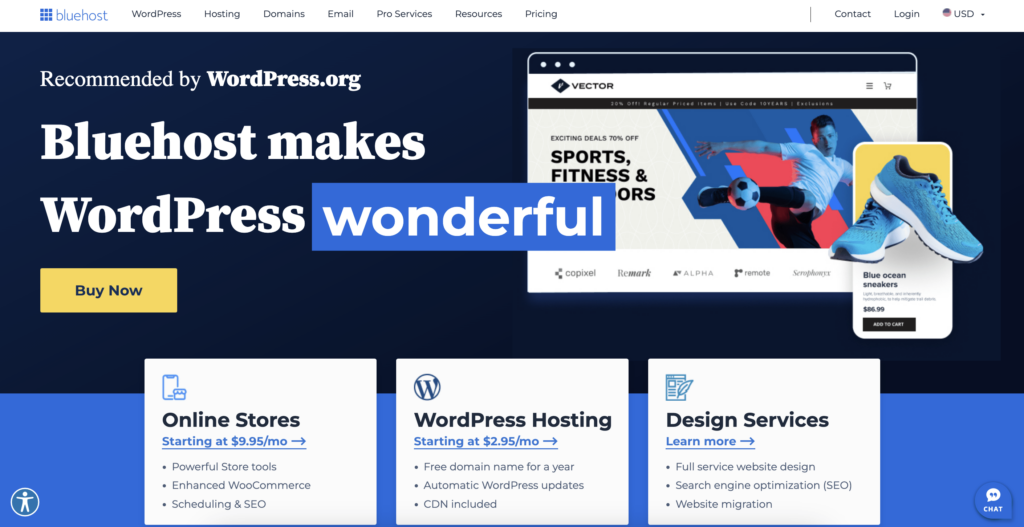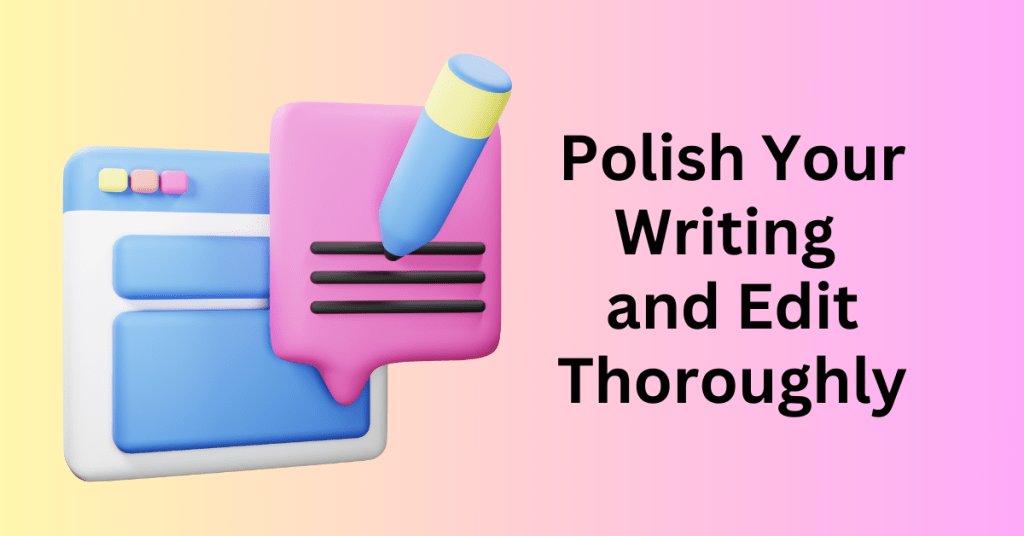Embarking on the exhilarating journey of blogging is like opening the door to a world where your thoughts, ideas, and expertise can resonate with a global audience. Whether you’re a budding entrepreneur, a passionate hobbyist, or a professional looking to establish your online presence, crafting your first blog post is a pivotal moment. In this guide, we delve into the art and science of writing that focus on driving conversions.
You’re not just here to share words. Instead, you’re here to make an impact, to turn curious visitors into loyal followers, and perhaps even customers. Let’s embark on this enlightening journey together, unlocking the potential of your first blog post to leave a lasting impression on your audience and drive meaningful conversions.
Start Your WordPress Blog Today – limited time up to 75% discount
Factors to consider when choosing a blogging platform
When choosing a blogging platform, several factors should be carefully considered to ensure that the selected platform aligns with your specific needs and goals. One crucial aspect is ease of use. A user-friendly interface is essential for both beginners and experienced bloggers. It can streamlines the content creation process and allows for efficient management of the blog.
Another important consideration is customization options. The ability to personalize the look and feel of your blog is crucial for establishing a unique online presence. Look for a platform that offers a variety of themes, layouts, and customization tools to help you create a blog that reflects your brand or personal style.
Scalability is also a key factor. As your blog grows, you may need additional features and resources. You need to choose a platform that can accommodate your future needs, whether it’s handling increased traffic, integrating e-commerce functionalities, or supporting multimedia content.
Additionally, consider the platform’s community and support resources. A robust community can provide valuable insights, troubleshooting tips, and a sense of camaraderie. Adequate support from the platform itself, through documentation, tutorials, and customer service, is crucial for resolving issues and navigating the technical aspects of blogging.
Moreover, the SEO (Search Engine Optimization) capabilities of the platform are vital for improving the visibility of your blog in search engine results. A platform that allows you to optimize your content easily, implement metadata, and manage other SEO aspects is advantageous for reaching a broader audience.
Considering the security features of a blogging platform is also crucial. You need to ensure that the platform follows best practices for online security to protect your content and user data. Regular updates and a secure infrastructure are indicators of a platform’s commitment to maintaining a safe environment.
WordPress CMS for Blogging
Taking into account these factors, WordPress emerges as a highly suitable choice for a blogging platform. WordPress is renowned for its user-friendly interface, extensive customisation options, scalability, large and active community, robust support resources, excellent SEO capabilities, and commitment to security.

Its versatility makes it suitable for both beginners and experienced bloggers. Besides, its open-source nature allows for endless possibilities in terms of customization and functionality. Overall, WordPress stands out as a reliable and powerful choice for individuals and businesses looking to establish a successful and sustainable online presence through blogging.
Start Your WordPress Blog Today – limited time up to 75% discount
How to write your first blog post
Embarking on the journey of creating your first blog post is an exciting venture that opens up a world of self-expression and communication. Whether you’re a seasoned writer or a novice looking to share your passion, the process of crafting a compelling blog post requires careful consideration and strategic planning. Here’s the step-by-step guide to ensure your first blog post not only captures your unique voice but also resonates with your intended audience.
Step 1: Define Your Purpose and Audience – Write and Publish Your First Blog Post
Defining your purpose and audience is a foundational step in creating a successful blog. Your purpose serves as the guiding principle that shapes your content while understanding your audience ensures that your message resonates with the right people.
Begin by asking yourself why you want to start a blog. Is it to share personal experiences, offer expert insights, or entertain your readers? Your purpose should align with your passion and expertise, as this authenticity will translate into engaging content. If your goal is to inspire, educate, or provoke thought, clarify this intention as it will serve as the driving force behind your writing. This purpose will not only give your blog a sense of direction but will also attract like-minded individuals who resonate with your goals.

Equally important is understanding your audience. Consider who you want to reach with your content – demographics, interests, and preferences. This understanding allows you to tailor your writing style, tone, and topics to cater to your target readers. You can do this by researching to identify your potential audience’s needs and challenges. You may even create reader personas to visualize and empathize with your audience. By doing so, you’ll be better equipped to deliver content that addresses their concerns, captures their attention, and builds a sense of connection, fostering a dedicated readership.
Step 2: Choose a Relevant and Captivating Topic – Write and Publish Your First Blog Post
Choosing a relevant and captivating topic is a critical step in the process of writing a compelling blog post. The topic sets the tone for your entire piece, influencing whether readers are drawn in or quickly lose interest.
Firstly, you can start by considering your niche or the overarching theme of your blog. If you’re a lifestyle blogger, for example, you might explore topics related to travel, fashion, wellness, or personal development. If your blog is more specialized, such as in technology or finance, your topics will revolve around those specific areas.

To choose a relevant topic, stay informed about current trends and conversations within your niche. You need to follow industry news, engage with your community, and be aware of the challenges and questions your audience is facing. This awareness will enable you to identify gaps in existing content or provide a unique perspective on popular topics.
Additionally, consider your interests and expertise. Writing about subjects you are passionate about or knowledgeable in will not only make the writing process more enjoyable but will also enhance the authenticity and depth of your content.
Once you’ve identified a relevant topic, focus on making it captivating. Look for angles that can spark curiosity or elicit an emotional response from your readers. You can do it by crafting a captivating topic that involves finding the intersection between your passion, your audience’s interests, and the uniqueness of your perspective. Besides, use compelling language, ask thought-provoking questions, or create a sense of urgency to encourage readers to delve into your content. A captivating topic serves as the entry point to your blog post, enticing readers to explore further and discover the valuable insights you have to offer.
Step 3: Conduct Thorough Research – Write and Publish Your First Blog Post
Conducting thorough research is a crucial step in creating a well-informed and credible blog post. Whether you’re sharing personal experiences or presenting factual information, a solid foundation of research enhances the depth and quality of your content. Begin by identifying reputable sources within your niche, such as industry publications, scholarly articles, or expert blogs. Peer-reviewed journals and established websites can provide accurate and up-to-date information, ensuring the reliability of your content.

As you delve into your research, take comprehensive notes to organize your findings and facilitate the later writing process. You should consider creating an annotated bibliography or document summarizing key points from each source. This not only helps you understand the nuances of the topic but also provides a quick reference during the writing phase. Be critical of the information you encounter, verifying facts from multiple sources to ensure accuracy. Additionally, consider incorporating diverse perspectives to present a well-rounded view and add depth to your blog post.
A key aspect of effective research is staying current with the latest developments in your niche. You can do that by checking for updates, new studies, or changes in industry trends regularly to ensure that your content remains relevant and up to date.
Besides, by engaging with online forums, social media communities, and industry events, you can stay connected with ongoing conversations. By staying vigilant in your research efforts, you position yourself as a trustworthy and informed voice within your niche, earning the respect and credibility of your audience.
Step 4: Develop a Strong Outline – Write and Publish Your First Blog Post
Developing a strong outline is an important step in the blog writing process. A roadmap guides your thoughts and ensures a structured and coherent final piece. Start by organizing your ideas into distinct sections. Typically, an introduction, body, and conclusion. The introduction sets the stage for your blog post, introducing the topic and captivating your audience. It should include a hook, a clear statement of purpose, and a preview of what readers can expect.

The body is where you expand on your main points, presenting arguments, supporting evidence, and insights. Each subsection within the body should contribute to the overall narrative, ensuring a logical flow. Finally, the conclusion summarizes your key points and provides a satisfying closure, leaving a lasting impression on your readers.
Within each section of your outline, use bullet points or brief sentences to outline the key ideas you want to convey. This helps maintain a clear and organized structure, making it easier to flesh out your thoughts during the writing phase. You need to also consider the hierarchy of your points and use subheadings to break down complex ideas into more manageable sections. This not only enhances readability but also provides visual cues that guide your readers through the content. Your outline should serve as a comprehensive skeleton, capturing the essence of your blog post before you start drafting the actual content.
Flexibility is crucial during the outlining process. As you develop your outline, be open to adjustments and refinements. It’s common for ideas to evolve or for new insights to emerge during the writing process, and your outline should be adaptable to these changes. A strong outline acts as a compass, keeping you on track while allowing for creative exploration.
Step 5: Craft a Compelling Introduction – Write and Publish Your First Blog Post
Crafting a compelling introduction is paramount to capturing your audience’s attention and encouraging them to delve further into your blog post. Begin with a hook—a captivating sentence or two designed to grab the reader’s interest. This could be a thought-provoking question, a startling statistic, a relatable anecdote, or a bold statement. The goal is to create an immediate connection with your audience, prompting them to continue reading to discover more. A well-crafted hook sets the tone for the entire blog post, establishing intrigue and anticipation.

Following the hook, clearly state the purpose of your blog post. Let your readers know what they can expect and why your content is relevant to them. This not only provides transparency but also helps manage expectations. It ensures that your audience understands the value your blog post offers. Additionally, provide a brief overview of the main points you’ll be discussing in the body of your post. This roadmap gives readers a sense of the structure and direction of your content. It will make it easier for them to follow along and stay engaged.
Balance is key when crafting your introduction. While it should be attention-grabbing, it should also seamlessly transition into the main body of your blog post. Avoid providing too much detail in the introduction; instead, offer a taste of what’s to come. Consider the tone and style of your writing—whether it’s formal, conversational, or humorous—and ensure consistency throughout the introduction. By striking the right balance and maintaining a clear focus on your purpose, you set the stage for a compelling and cohesive blog post that resonates with your audience from the very beginning.
Step 6: Write Engaging and Informative Content – Write and Publish Your First Blog Post
Writing engaging and informative content is the heart of a successful blog post. Start by maintaining a conversational tone that connects with your audience. Imagine you’re having a one-on-one conversation with a friend. This approach helps to make your content more relatable and accessible, ensuring that readers feel a personal connection to the material. Additionally, use anecdotes or personal experiences to illustrate your points. This can provide a human touch to your writing that keeps readers invested.

Incorporate a variety of elements to make your content visually appealing and easy to digest. Break up long paragraphs into shorter ones and use subheadings to guide readers through different sections. Utilize bullet points and numbered lists to present information in a clear and organized manner. Visual elements such as images, infographics, or relevant videos can also enhance the overall readability and engagement of your blog post. A balance between text and visuals is key to keeping your audience interested and preventing them from feeling overwhelmed.
Ensure that your content is well-researched and supported by reliable sources. Cite statistics, studies, or expert opinions to add credibility to your arguments. When presenting information, strive for clarity and conciseness. Avoid jargon or overly technical language, unless your audience consists of experts in your field. Use examples and real-world scenarios to help readers grasp complex concepts. Ultimately, the goal is to provide valuable and actionable insights that leave a lasting impact on your audience, making them eager to return for more.
Step 7: Polish Your Writing and Edit Thoroughly – Write and Publish Your First Blog Post
Polishing your writing through thorough editing is a crucial step in ensuring the professionalism and effectiveness of your blog post. After completing the initial draft, take a step back before diving into the editing process. This distance allows you to approach your writing with a fresh perspective, making it easier to identify areas needing improvement.

Begin by focusing on the overall structure and coherence of your content. You need to ensure that your ideas flow logically from one paragraph to the next. This can create a seamless narrative that guides the reader through your blog post effortlessly.
Next, shift your attention to the finer details of your writing. You need to eliminate unnecessary words or redundant phrases to tighten your prose and enhance clarity. Besides, pay careful attention to grammar, spelling, and punctuation to maintain a professional and polished presentation.
You have to consider the tone and style of your writing, ensuring consistency throughout the entire blog post. Reading your work aloud can be a helpful technique to catch errors and assess the overall flow of your writing. Additionally, be mindful of the length of your sentences and paragraphs, striving for a balance that maintains engagement without overwhelming the reader.
Finally, seek feedback from others during the editing process to gain valuable insights and perspectives. Another set of eyes can catch errors or areas of confusion that you may have overlooked. If possible, engage with an editor or consider utilizing online tools to check for grammar and spelling issues.
Editing is a crucial phase in refining your blog post into a polished and professional piece of content. By investing time and attention to detail in this step, you ensure that your writing is not only error-free but also communicates your message effectively to your audience.
Step 8: Add Visual Elements – Write and Publish Your First Blog Post
Adding visual elements to your blog is a powerful way to enhance the overall appeal and impact of your content. Start by incorporating high-quality and relevant images that complement your written text. Images not only break up large chunks of text, but making your content more visually appealing. Instead, they also serve to reinforce your message and provide additional context. You should ensure that the images you choose align with the tone and theme of your blog post. This can create a cohesive visual experience for your readers.

Consider utilizing infographics or charts to present data or complex information in a more digestible format. Visual aids can significantly enhance the understanding of your content and make it more accessible to a broader audience. Infographics, in particular, are effective in condensing information into a visually engaging format that encourages readers to stay engaged. When creating or selecting visuals, prioritize clarity and simplicity to ensure that your audience can quickly grasp the intended message without feeling overwhelmed.
Incorporate other multimedia elements such as videos or embedded social media posts to diversify your content and cater to different learning preferences. Videos can provide a dynamic and interactive dimension to your blog post. It allows you to share demonstrations, interviews, or additional insights. Embedding social media content allows you to leverage user-generated content or showcase relevant discussions within your niche. The strategic use of visual elements not only enhances the aesthetics of your blog but also contributes to a more engaging and memorable reader experience. This will ultimately increasing the likelihood of reader retention and sharing.
Step 9: Optimize for SEO – Write and Publish Your First Blog Post
Optimizing your blog post for search engines (SEO) is crucial for increasing its visibility and attracting organic traffic. Firstly, start by conducting keyword research to identify relevant terms and phrases related to your blog post. You can utilize tools like Google Keyword Planner or other SEO to discover high-traffic keywords that align with your content. Then, integrate these keywords strategically into your blog post. This includes in the title, headers, and throughout the body. However, it’s essential to maintain a natural and reader-friendly flow. Avoid keyword stuffing as it can negatively impact the user experience and SEO ranking.

Craft a compelling meta description that summarizes the essence of your blog post and encourages users to click. The meta description is the brief snippet that appears in search engine results, providing a concise preview of your content. You need to ensure that it includes your primary keyword and entices readers to explore further. Additionally, optimize your images by using descriptive file names and alt text. Alt text not only improves accessibility for users with visual impairments but also provides search engines with information about the content of your images, contributing to SEO.
Finally, consider the structure of your URL to make it SEO-friendly. Use a clear and concise URL that includes relevant keywords, making it easy for search engines and users to understand the content of your page. Create a logical hierarchy with subdirectories, if applicable, to organize your blog post URLs.
Internally link to other relevant pages on your blog to improve navigation and provide additional context for search engines. Externally, link to reputable sources to enhance the credibility of your content. By implementing these SEO strategies, you increase the likelihood of your blog post ranking higher in search engine results, driving more organic traffic to your site.
Step 10: Promote Your Blog Post – Write and Publish Your First Blog Post
Promoting your blog post is a crucial aspect of reaching a wider audience and maximizing its impact. Start by leveraging the power of social media platforms. Share your blog post across various channels, customizing your messaging to suit the unique characteristics of each platform. Utilize relevant hashtags to increase discoverability and engage with your audience through compelling captions. Encourage your followers to share your content, expanding its reach organically. Additionally, consider scheduling multiple posts over time to ensure that your blog post continues to gain visibility.

Engage with online communities and forums within your niche. Share your blog post where appropriate, ensuring that your participation adds value to the conversation. Avoid overly promotional language, and focus on contributing insights or solutions to the community’s interests. Building relationships within these communities not only promotes your blog post but also establishes you as an active and trusted member of the online community. Be genuine in your interactions and respond to comments or questions to foster a sense of connection.
Explore guest posting opportunities on other blogs within your niche. Contributing high-quality content to established platforms not only exposes your blog to a new audience but also enhances your credibility in the industry. Craft a compelling bio that includes a link back to your blog, inviting readers to explore more of your content.
Additionally, consider collaborating with influencers or other bloggers in your field. Influencers can amplify your reach by sharing your blog post with their followers, providing access to a broader audience. Collaborations also strengthen your network within the blogging community, opening doors to future promotional opportunities.
Start Your WordPress Blog Today – limited time up to 75% discount
Beginner mistakes to avoid when writing your first blog post
Embarking on the journey of blogging can be both exciting and challenging, especially for beginners. Crafting your first blog post is a significant step, and while enthusiasm is crucial, it’s equally important to steer clear of common pitfalls. In this section, we’ll explore some of the typical mistakes beginners make when writing their initial blog posts and how to avoid them.
Lack of Planning
One of the most common mistakes new bloggers make is diving into writing without a clear plan. Before you start typing away, take some time to brainstorm and outline your ideas.
Define your target audience, the main message you want to convey, and the structure of your post. A well-thought-out plan will make the writing process smoother and help you stay focused on your key points.
Ignoring the Importance of Headlines
Your blog post’s headline is the first thing readers see, and it plays a crucial role in capturing their attention. Avoid generic titles and strive to create compelling headlines that spark interest and curiosity.
Use keywords relevant to your content and ensure your headline reflects the value your post provides.
Neglecting Proofreading and Editing
Typos and grammatical errors can undermine the credibility of your blog. Before hitting the publish button, thoroughly proofread your post. Consider using grammar-checking tools and, if possible, get a second pair of eyes to review your work.
A polished, error-free post demonstrates professionalism and enhances the overall reading experience.
Overlooking SEO Basics
Search Engine Optimization (SEO) is vital for increasing your blog’s visibility. Neglecting SEO basics, such as incorporating relevant keywords, creating descriptive meta-tags, and using alt text for images, can hinder your post’s discoverability.
Research and implement fundamental SEO practices to enhance your blog’s chances of ranking well in search engine results.
Failing to Engage Readers
A successful blog post not only informs but also engages its audience. Avoid being overly formal or robotic in your writing. Connect with your readers by using a conversational tone, asking questions, and encouraging comments.
Besides, you should also include relatable anecdotes or personal experiences can also help establish a connection with your audience.
Disregarding Visual Appeal
A wall of text can be intimidating and uninviting to readers. Break up your content into manageable paragraphs, use subheadings, and incorporate visuals like images, infographics, or videos.
A visually appealing layout enhances the overall reading experience and makes your blog post more shareable.
Neglecting Social Media Promotion
Even the most well-crafted blog post may go unnoticed if you don’t promote it effectively. Share your post on your social media platforms, engage with your audience, and participate in relevant online communities.
Building a social media presence is crucial for driving traffic to your blog and fostering a community around your content.
Start Your WordPress Blog Today – limited time up to 75% discount
Final thoughts: How to write your first blog post to drive conversions
Writing is not just about putting words on a digital canvas. It’s about creating a connection, sparking interest, and guiding your audience toward a meaningful response. We’ve unveiled the strategies and nuances that can transform your words into a dynamic force capable of inspiring action.
As you embark on your blogging journey, armed with insights on audience engagement, compelling storytelling, and strategic calls to action, let confidence be your guide. Your first blog post is not just a mere introduction. Instead, it’s the foundation upon which your digital presence is built.
Craft each sentence with intention, every headline with purpose, and every call to action with a clear path for your readers to follow. Your blog isn’t just a space for sharing thoughts; it’s a platform for building a community, fostering connections, and, yes, driving conversions.
So, whether you’re here to showcase your expertise, share your passion, or promote your business, remember the power that lies in your words. Your first blog post is the spark that ignites a journey, and each subsequent post adds to the flame, creating a vibrant and engaging presence in the vast digital landscape.
Your journey to becoming a successful blogger starts with choosing the right blogging platform. That’s why Bluehost offers top-quality WordPress hosting that lets you build your own blog from scratch.
With Bluehost, you can go from learning how to write your first blog post to getting a free domain name and building fast-loading webpages.
Kickstart your blogging journey with WordPress hosting plans today.
Start Your WordPress Blog Today – limited time up to 75% discount





